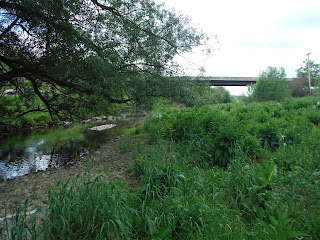At this point in the year all of the adult American brook lamprey have passed along, but many of the ammocoetes are now getting to maximum size so they can undergo metamorphosis and become adults of their own. The largest ammocoete I have ever captured I captured this time (the total weight was 22.6 grams (0.80 oz for those on the English system. This does not sound like much, but keep in mind these animals may only weigh 1 g after a full year of growth, so to make it to 22 grams probably takes more than 5 years. Wait that doesn't make sense, 22 divided by 1 should be 22. Keep in mind that growth is exponential (not linear), so as an animal grows it gets easier to put on weight assuming food is around, and the rate of growth speeds up as the animal gets older.
Enough talk, let us look at some pictures.
A large dead carp (Cyprinus carpio) rotting quietly on the edge of the stream. I found another dead carp further down stream and suspect that someone fished for them a little while ago. Before you pass judgement upon wasteful fishers, I would suggest you commend this person for killing an invasive pest. Carp are not native to North America, they were brought over by Europeans who wanted a large food fish that could eat plants. Unfortunately, carp love plants, and they will consume them until they clear the bottom, while doing so they stir up mud. As a result areas with lots of carp can turn from clear water to muddy pools very quickly. Even more annoyingly they kill aquatic plants which many native species rely upon. Carp are too widespread to do much with today, but keep in mind that goldfish are closely related. Release of goldfish into the wild is very common, I should know I catch them regularly. If you have a fish that you don't want anymore, kill it and then dispose of the body, please don't release non-native fish.
The creek is starting to green up, many of these plants have grown up again since I was last here in May.
A very small lamprey ammocoete (<80 mm) just before it gets tagged.
A drift net I have been setting at night in the hopes of catching ammocoetes on the move. To date I have not yet caught any with it, but we will see if I don't catch one by the end of the summer.
Below is a series of photos showing the steps in marking of a lamprey.
Address the lamprey, preferably by name, also make sure to take its length and weight.
The first injection just over the gills.
Two done, two more to go.
Third one being done. Note how shallow the needle is you can still see it. I am literally just under the skin of the animal, no permanent harm and the animal is asleep so it won't even feel it.
All done, all the marks in place and the animal is ready to go back into a bucket to recover. Total time: ~1 minute.
An interesting animal I captured this time. I have now captured 1000's of animals so I have seen slight variations from wounds and birth marks in ammocoetes, but this animal appears to have a deformed tail. The tail folded back over on itself and was stuck in that format. The cartilage had already grown too stiff to unfold the tail. I suspect this animal lost the tip of its tail and it regrew incorrectly, although it is possible it has always had this deformation.
All of the green you see before me grew up in a month. Spring has sprung and we are entering summer.
A day done. The last sampling pool with all of its lampreys ready to go. Some are fully recovered others are going to take a few minutes to come all the way back around.
I will attempt to expand the reach of the blog in the future by posting lectures that deal with the theory behind the work I am doing. However, if you are not interested do not fear, I will mark them clearly so you can ignore them if you do not find them interesting.














What do you use as anesthesia? MS-222, benzocain?
ReplyDeleteFIRST COMMENT! Congratulations Nate! You win nothing, but the pride of being the first.
ReplyDeleteActually I use the same stuff you put in pumpkin pie, clove oil. Clove oil is used to deaden nerves, and when animals are soaked in it they go under. It is extremely difficult to overdose and has the added benefit of numbing pain when I use the needles.
Ah the herbalist route. I've heard of that being used before.
ReplyDelete